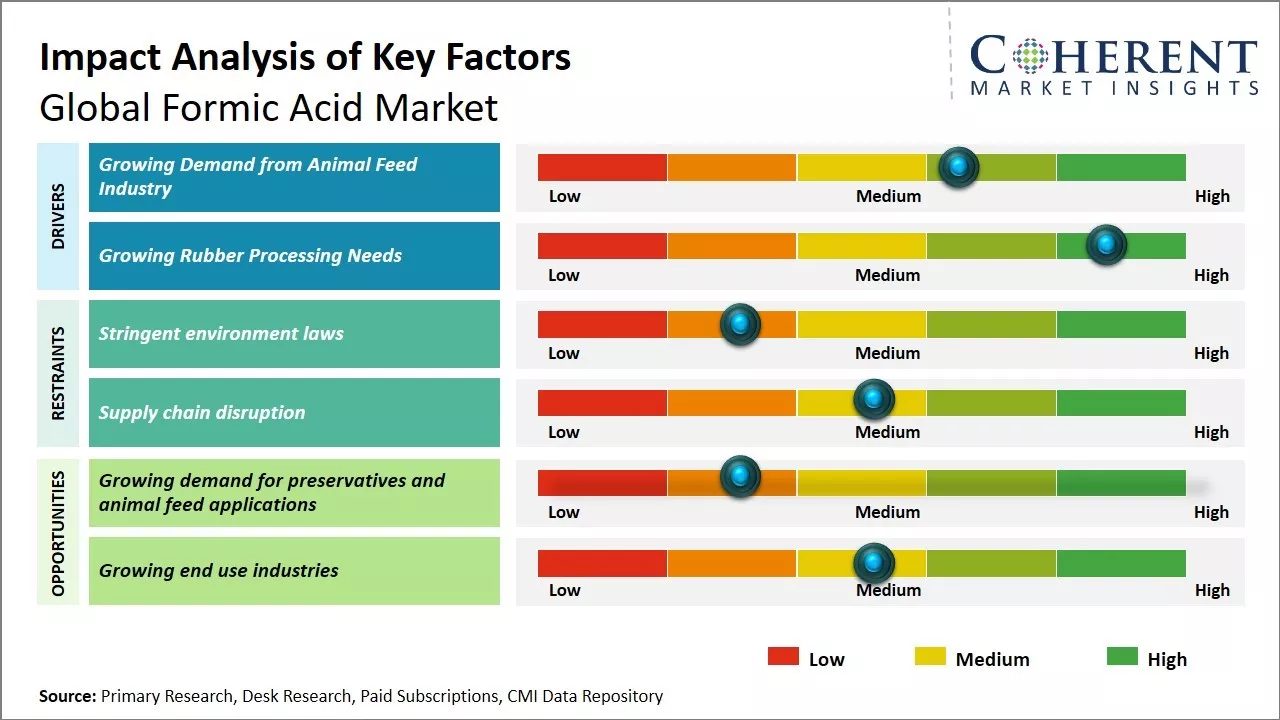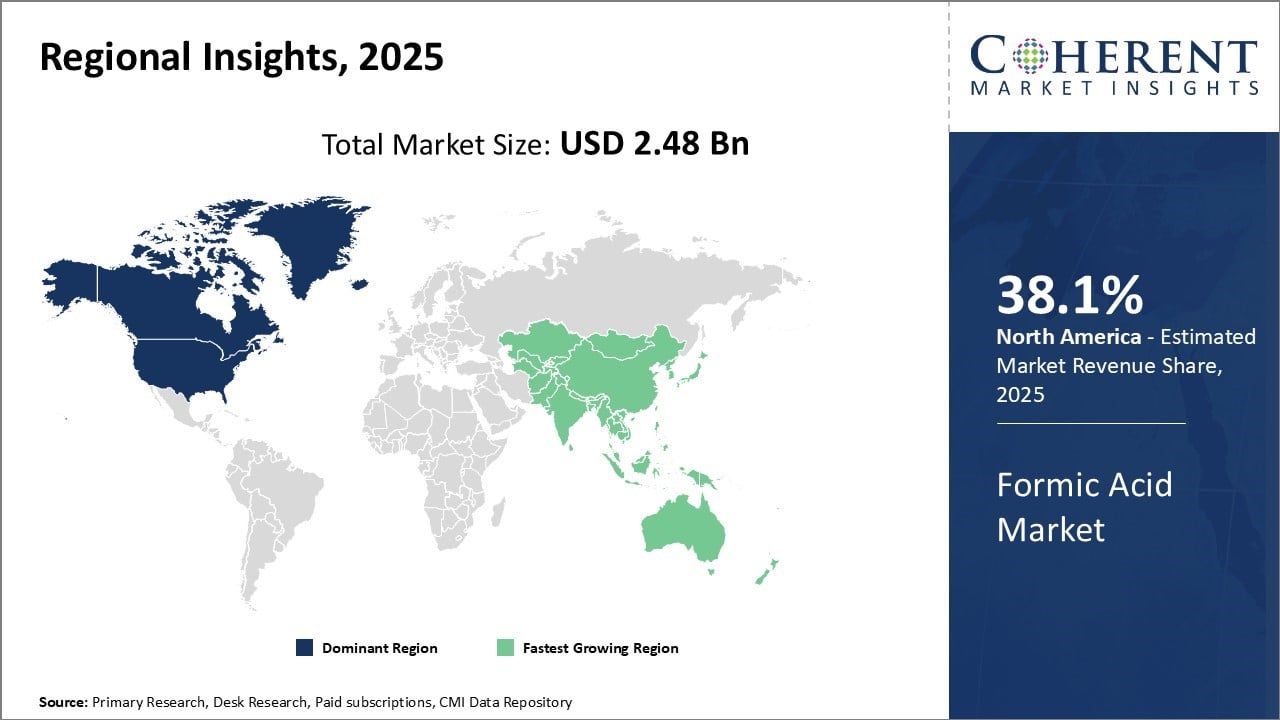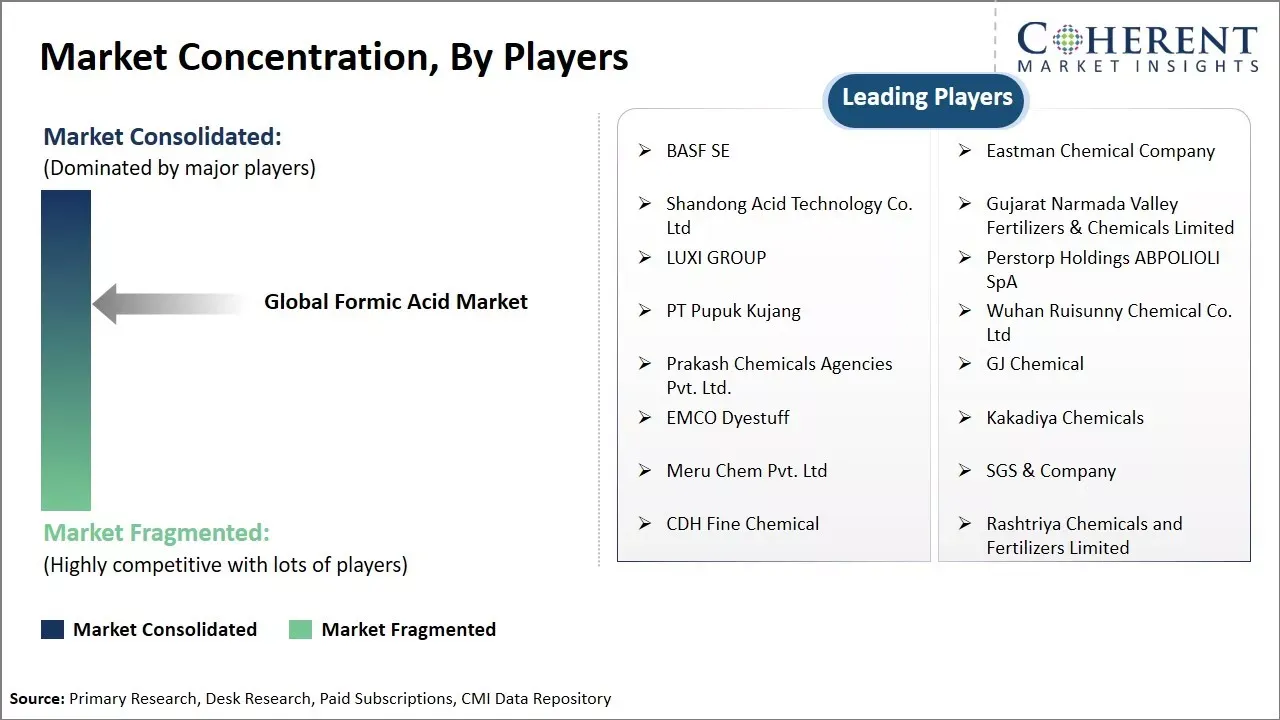Formic Acid Market is estimated to be valued at USD 2.48 Bn in 2025 and is expected to reach USD 3.68 Bn in 2032, exhibiting a compound annual growth rate (CAGR) of 5.8% from 2025 to 2032.

To learn more about this report, Download Free Sample
The Formic Acid Market Size is fueled by ongoing technological advancements and sustainability initiatives in production. Formic acid is mainly used as an animal feed additive and silage preservative. It plays a key role in food preservation and improving the nutritive value of forage crops, and is increasingly incorporated into livestock feed with formic acid to enhance animal health and feed efficiency. The growing meat consumption and emphasis on food safety are projected to drive the need for formic acid as an animal feed preservative. Rising demand for high-value crops is also likely to boost the consumption of formic acid as a silage preservative. Banning of antibiotic growth promoters will further augment the demand.
|
Event |
Description and Impact |
|
Stricter EU Environmental Regulations |
|
|
Growth in Animal Feed and Silage Additive Demand |
|
Uncover macros and micros vetted on 75+ parameters: Get instant access to report
Formic acid prices in Europe have shown notable volatility due to fluctuations in raw material and energy costs. In Q1 2025, the average price of formic acid reached USD 815 per metric ton FOB-Hamburg, marking a 5.98% increase from the previous quarter.
This upward movement is primarily attributed to rising methanol prices methanol being the principal raw material for formic acid production, which saw price changes of nearly 45% in 2023. Additionally, energy expenses have become a significant component of total production costs, accounting for up to 20% for chemical manufacturers in Europe.
For example, if the total cost to produce one metric ton of formic acid is USD 815, approximately USD 163 (20%) would be attributed to energy costs alone. These cost pressures are directly impacting market prices, leading to higher costs for downstream industries such as animal feed, textiles, and leather.
Among the various type of formic acid available in the global market, grade 85% is expected to account for 53.1% share of the market share in 2025 owing to its widespread usage in applications that do not require the highest purity levels. As grade 85% formic acid is sufficient to achieve results in applications such as animal feed preservation and leather processing.
It provides an excellent price to performance ratio, making it the preferred choice for many end-use industries. Its ability to serve the needs of a variety of cost-sensitive applications at an affordable cost has enabled grade 85% formic acid to capture significant market share over the years.
The animal feed and silage additive segment is expected to hold 53.1% of the Formic Acid Market Share in 2025 in terms of formic acid usage due to its exceptional preservative properties. Formic acid is highly effective at preventing the growth of undesirable molds and bacteria when used as an additive for livestock feed and silage, allowing farmers to store high-moisture crops for long periods without significant spoilage.
Its widespread adoption in this application can be attributed to the growing demand for meat and dairy products globally. As livestock producers look to maximize yields through improved feed preservation techniques, the demand for formic acid from the animal feed segment is expected to continue increasing substantially in the coming years.

To learn more about this report, Download Free Sample
North America has established itself as the dominant region in the global formic acid market over the past few decades and is expected to hold 38.1% of the market share in 2025. With the large presence of key manufacturers from countries like the U.S. and Canada, the region accounts for the lion's share of the global production capacity.
The region is home to several manufacturing facilities of industry leaders who have pioneered production technologies for formic acid. In addition, the wide availability of raw materials and growth of end-use industries have further aided Formic Acid Market Growth.
North America also has a well-developed transportation and logistics infrastructure which helps in the easy movement of formic acid and related products within the region and overseas.
Asia Pacific has emerged as the fastest growing regional market for formic acid in recent years. Countries like China and India serve as major production and consumption hubs, spurred by their expanding industrial sectors. These countries have witnessed rapid urbanization and economic development which has bolstered demand from applications such as animal feed, leather, and rubbers.
Government initiatives promoting manufacturing have also led to big investments from leading companies to set up or expand production capacities. Additionally, growth of small and medium enterprises engaged in formic acid production and end-use segments have supplemented the regional market growth.
Robust agricultural and livestock industries have further augmented demand. The region also has geopolitical advantages of proximity to key export markets which supports its rising exports of formic acid.
Germany is the market leader, using over 35% of the formic acid used in Europe. This dominance is backed by the country's robust chemical industrial infrastructure and large R&D expenditures. In contrast, Spain is the market with the quickest rate of growth in the region, driven by its developing agricultural sector and rising usage of formic acid in the leather and textile industries as well as in the preservation of animal feed.
The food and beverage, pharmaceutical, and personal care sectors high demand along with developments in automation and packaging technology are fueling the market for Formic Acid in the U.S. the growth of packaged consumer goods, the demand for sanitary and effective filling procedures, and strict packaging laws are important growth drivers.
India's growing industrial base and robust agricultural sector are driving the country's rise as a major formic acid production and consumption hub. The demand for formic acid as a preservative and antibacterial agent in animal feed is driven by the significant dairy and cattle sectors in the nation.
Furthermore, formic acid is essential to tanning and dyeing processes in India's leather and textile sectors, which are among the fastest-growing in the world. Guidelines for the shipping of Formic Acid are also becoming increasingly important as the market expands, ensuring safe handling and transportation of this vital chemical across the country.
China produces more than half of the world's formic acid, making it the market leader. The expansive livestock industry, which creates a high demand for formic acid in animal feed and silage preservation, is the foundation of the nation's leadership. The extensive leather and textile industries in China are also a major source of formic acid use, especially during the tanning and dyeing operations.
| Report Coverage | Details | ||
|---|---|---|---|
| Base Year: | 2024 | Market Size in 2025: | USD 2.48 Bn |
| Historical Data for: | 2020 To 2024 | Forecast Period: | 2025 To 2032 |
| Forecast Period 2025 to 2032 CAGR: | 5.8% | 2032 Value Projection: | USD 3.68 Bn |
| Geographies covered: |
|
||
| Segments covered: |
|
||
| Companies covered: |
BASF SE, Eastman Chemical Company, Shandong Acid Technology Co. Ltd, Gujarat Narmada Valley Fertilizers & Chemicals Limited, LUXI GROUP, Perstorp Holdings ABPOLIOLI SpA, PT Pupuk Kujang, Wuhan Ruisunny Chemical Co. Ltd, Prakash Chemicals Agencies Pvt. Ltd., GJ Chemical, EMCO Dyestuff, Kakadiya Chemicals, Meru Chem Pvt. Ltd, SGS & Company, CDH Fine Chemical, and Rashtriya Chemicals and Fertilizers Limited |
||
| Growth Drivers: |
|
||
| Restraints & Challenges: |
|
||
Uncover macros and micros vetted on 75+ parameters: Get instant access to report

To learn more about this report, Download Free Sample
Formic acid has emerged as an important preservative and acidifying agent for animal feed over the past decade. It helps inhibit the growth of molds and bacteria in livestock feed, extending its shelf life. With the consumer demand for meat and protein growing steadily worldwide, the animal feed industry has been expanding exponentially. Developing countries with increasing meat consumption like China and Brazil have ramped up commercial meat production. This has fueled the demand for high-quality commercial feed globally.
Feed producers are increasingly adopting formic acid as it allows them to store compound feed for longer periods without deterioration in quality. This helps ensure the supply is maintained throughout the year for large livestock operations. Formic acid also improves feed conversion and digestion when used as an additive.
Some studies have shown it can enhance weight gain and growth in poultry and pigs when supplemented in fiber-rich diets. With farmers looking to maximize productivity amid rising costs, formic acid offers an affordable solution.
Regulatory acceptance of its use within limits in animal feed in major markets has further boosted commercial interest. The drive for protein self-sufficiency in Asia Pacific and other regions will support the rise of large-scale concentrated animal farming. This bodes well for the prospects of formic acid, finding greater uptake as a feed preservative and performance enhancer.
Key factor propelling the demand for formic acid worldwide is the expansion of the rubber industry. Formic acid is extensively consumed in the processing of various types of rubber including synthetic and natural rubber. It acts as a catalyst during the final stage of synthesizing styrene butadiene rubber which finds wide usage in tire manufacturing.
Almost 60% of the global rubber production is currently dedicated to tire manufacturing. With rising vehicle ownership and increasing replacement needs, the annual global tire production has been growing steadily at over 3% in recent years. This steady growth in the downstream tire industry naturally augurs well for formic acid consumption.
Apart from tires, formic acid also plays an important role in processing rubber for other industrial products like conveyor belts, hoses, footwear, and others. Using formic acid in apiculture is another notable application, where it is utilized for controlling mite infestations in beehives. As infrastructural development continues in emerging markets, the demand for such industrial rubber will keep rising. Synthetic rubber is also replacing natural rubber in many applications due to its superior properties.
Production of formic acid needs strictly controlled conditions to maintain quality and safety standards. Fluctuating prices of raw materials used in formic acid production adds to the challenges of cost control and business viability.
Environmental regulations governing industrial emissions are becoming more stringent over time in many countries, requiring investments in abatement technology. Transport and storage of formic acid also requires specialized equipment and safety protocols due to its corrosive nature.
A number of noteworthy developments are influencing the formic acid market's growth and prospects. The growing demand from the animal feed sector, which uses formic acid as an acidifying and preservative to prolong the shelf life of livestock feed and enhance animal health, is one of the most important trends.
The demand for safe, high-quality animal protein, especially in developing nations, and the increase in meat consumption worldwide are the main drivers of this trend. The use of formic acid as a safer substitute for antibiotic growth promoters to improve feed quality and preservation has increased because several markets have banned them.
The move toward environmentally benign and biodegradable chemicals in sectors including rubber manufacturing, textile dyeing, and leather tanning is another significant development. As producers and authorities concentrate more emphasis on lowering environmental effect and enhancing worker safety, formic acid's position as a sustainable substitute is becoming more and more popular.
Ongoing technological developments in production techniques, such as the creation of more sustainable and effective synthesis methods, like direct synthesis from carbon dioxide and hydrogen utilizing sophisticated catalysts, complement this.
Demand for preservatives and animal feed applications is increasing with rising global meat consumption. Additionally, new applications in leather tanning and textile dyeing industries are expanding as well. As a platform chemical, it is seeing increased research into derivatives and end products with broader industrial uses. Efforts to make production technologies more efficient and improve waste handling can help tackle environmental issues and boost.
*Definition: Formic acid, also known as methanoic acid, is the simplest carboxylic acid with the chemical formula HCOOH. It is a colorless, fuming liquid with a pungent, penetrating odor and is completely miscible with water. Formic acid naturally occurs in the venom of ants and some stinging insects, as well as in certain plants like stinging nettles and in small amounts in various fruits and vegetables.
Share
Share
About Author
Vidyesh Swar is a seasoned Consultant with a diverse background in market research and business consulting. With over 6 years of experience, Vidyesh has established a strong reputation for his proficiency in market estimations, supplier landscape analysis, and market share assessments for tailored research solution. Using his deep industry knowledge and analytical skills, he provides valuable insights and strategic recommendations, enabling clients to make informed decisions and navigate complex business landscapes.
Missing comfort of reading report in your local language? Find your preferred language :
Transform your Strategy with Exclusive Trending Reports :
Frequently Asked Questions
Joining thousands of companies around the world committed to making the Excellent Business Solutions.
View All Our Clients